Lockwood Reservoir (2018)
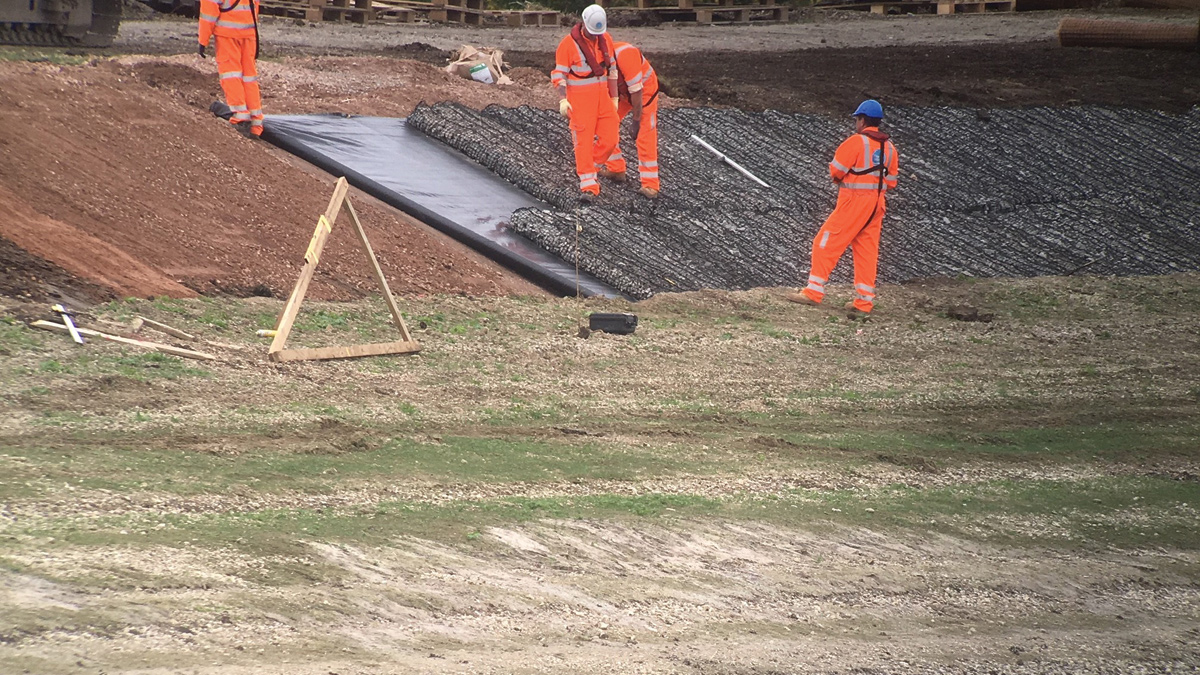
Multi-benefit innovative design of reservoir crest road and reservoir embankment protection
Lockwood Reservoir is one of ten Walthamstow reservoirs in north London and makes up part of Walthamstow Wetlands; Europe’s largest urban wetland nature reserve. It is also a Site of Special Scientific Interest (SSSI) and a Special Protected Area (SPA). The Wetlands attract 250,000 visitors a year and is a key site in London for both breeding and migrating birds. Walthamstow Wetlands is a 211 hectare operational site and main water supply for 3.5 million people. Thames Water and eight2O have undertaken a project to prevent erosion issues along a stretch of the reservoir embankment while enhancing the biodiversity of the reservoir. The robust and natural engineering solution included (i) rock mattresses for embankment protection from Salix River and Wetland Services (ii) lean crest road that reduced cost, carbon and time on site and (iii) pre and post works drone surveys for impact assessment and monitoring.
Project drivers
Improvement works were necessary to both the western reservoir bank and the crest road around the reservoir. A 720m section of the embankment was unprotected and had been suffering from significant wind and wave erosion, forming a notable notch above the top water level, and a series of inlets and shallow beaches.
The crest road around the reservoir was also not of sufficient integrity, containing soft spots that, through rutting caused by vehicle movement, posed a risk to the embankment clay core. There were also locations where no crest road was present at all.
The project team identified the innovative green infrastructure solutions of rock mattresses from Salix River and Wetland Services and turf reinforced matting to combat embankment erosion, the implementation of a lean crest road design and the trialling of unmanned aerial vehicles (drones) to study the impact of construction of a spatially large project on the surroundings.
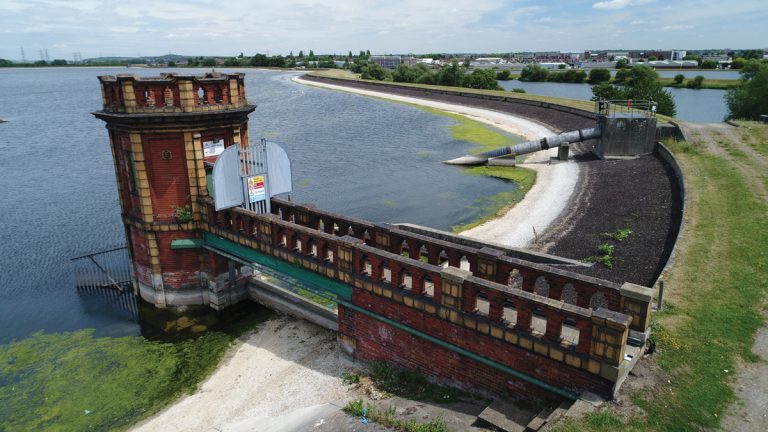
Lockwood Reservoir – Courtesy of Costain Group (eight2O Framework)
Design
The following AMP6 targets were set by Thames Water Utilities Ltd:
- 80% standardised products and early supply chain identification.
- 50% reduction in time on site.
- 20% TOTEX reduction.
- 50% reduction in carbon (embodied and operational).
- Zero loss of biodiversity.
Hence, the design process was carried out with these targets in mind. Moreover, due to the variety of interested external stakeholders (Walthamstow Wetlands, fisheries, visiting members of the public), it was decided that alternatives to traditional engineering solutions would be explored in order to reduce waste on site, vehicle movements and enhance the aesthetics of the site.
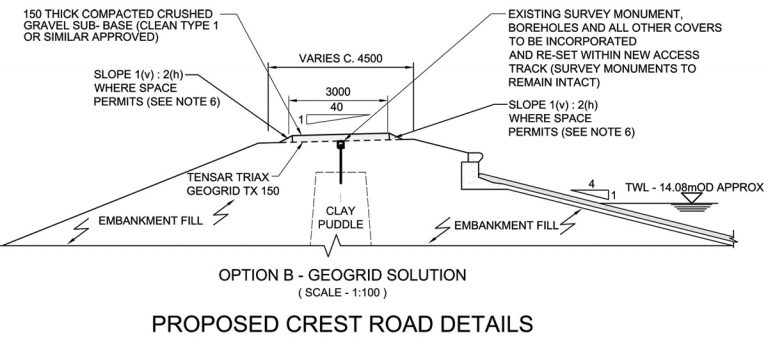
Proposed Crest Road details
Salix rock mattresses & turf reinforced matting
Traditional, hard engineered solutions to embankment erosion such as rip-rap, large stone gabion mattresses, or gabion baskets, are often unsightly, and lack biodiversity. The original business plan solution referred to a gabion mattress with geotextile and rip-rap and geotextile solutions. However, the project team identified and recommended ready filled Salix rock mattresses together with turf reinforced matting as an innovative alternative for embankment protection.
Salix rock mattresses are nets filled with small stones, delivered pre-filled to site. Seeded topsoil is then brushed onto the mattresses above top water level to encouraged plant growth. Turf reinforced matting then provides vegetated erosion protection.
Rock mattress installation
This solution provides the same level of embankment protection as traditional hard engineered solutions but has additional environmental and construction benefits. Salix rock mattresses allow greater areas of still water, where finer settlements can settle and vegetate, which combined with the turf reinforced matting promotes greater biodiversity and better wildlife habitat, particularly for aquatic invertebrates.
The more open cell size of the Salix mattresses provides greater performance against wave action and fluvial flows, and the vegetation growth enhances the visual appearance of the embankment for visitors to the wetlands.
In regards to quality of construction and improved health and safety, the prefilling of the mattresses off site means there is no movement of stone, and no manual handling of the mattresses is necessary.
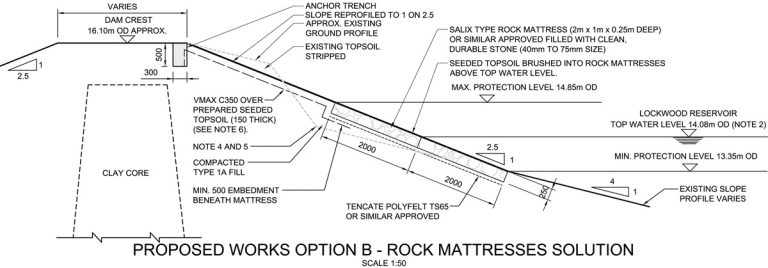
Proposed works Option B – Rock mattresses solution
Lean Crest Road
The conventional design for a reservoir crest road involved the excavation and removal of 200mm of the existing surface material and replacement with 200mm thick compacted crushed gravel to form the access track. The project team challenged conventional crest road designs and adopted a lean design by constructing on top of existing ground with minimal top soil removal (turf clearance only) to minimise waste. The new innovative crest road design involved 150mm of compacted crushed gravel sub-base laid on top of a Tensar Trax geogrid. The thickness of the crushed gravel sub-base was minimised to suit the existing ground CBR values.
The slim crest road design required minimal excavation and reduced use of aggregates that challenged existing crest road design norms.
This was important as the options for keeping excavation waste spoil on site were limited due to it being publicly accessible, a Site of Special Scientific Interest and the surrounding areas are designated flood plains and/or third party owned. Moreover, removing waste from site with HGVs would disturb birds and other wildlife, as well generating additional cost.
Construction
Construction began in July 2017 starting with the construction of the crest road, which was completed September 2017. The crest road works required that the entire reservoir be fenced off from the public, so this was carried out first in order to remove the fencing from the eastern bank by September and open public access to that side of the reservoir. This was driven by Walthamstow Wetlands’ opening of the site in October 2017, following their works to make the area more accessible.
The second phase of work, the embankment protection, began in September 2017 and was completed by November 2017. The contractor, Salix River and Wetland Services, supplied and installed the rock mattresses and is the only company to be using this type of rock mattress in the UK, with Lockwood Reservoir understood to be the first time they have been used on a UK water company reservoir. The entire project was taken over by the client on 27 November 2017.
Lockwood Reservoir Embankment Protection: Table of designers, contractors and suppliers
- Principal designer: Stantec UK
- Principal contractor: SMB JV
- Crest Road sub-contractor: Barton Construction
- Rock mattresses supplier & contractor: Salix River and Wetland Services
Results and future potential: Embankment works
The installation of the Salix rock mattresses over traditional solutions yielded a multitude of benefits. Subcontract tenders received were approximately £650k for the gabion stone solution and £350k for the Salix solution. It proved to be a safer and more cost effective way to protect reservoir embankments, saving around £104/m2.
The Salix River and Wetland Services installation also contributed to a 66% reduction in total time on site for the project (target of 50%), and resulted in a biodiversity net gain. The total expenditure reduction for the project was £831,000 (63%), 89% of which can be attributed to the Salix mattresses.
The small-stone Salix mattresses and grass reinforced matting used in this project provides a proven new greener solution for future reservoir embankment works across the water industry that – if taken up by the other water companies – may enable a gradual transition from grey infrastructure to green infrastructure over the course of the 21st century, which will contribute to the UK’s biodiversity targets.
The contractor, Salix River and Wetland Services, that installed the rock rolled mattresses are the only company to be using this type of rock mattress and it is believed that Lockwood Reservoir is the first time that they have used them on a UK water company owned reservoir.
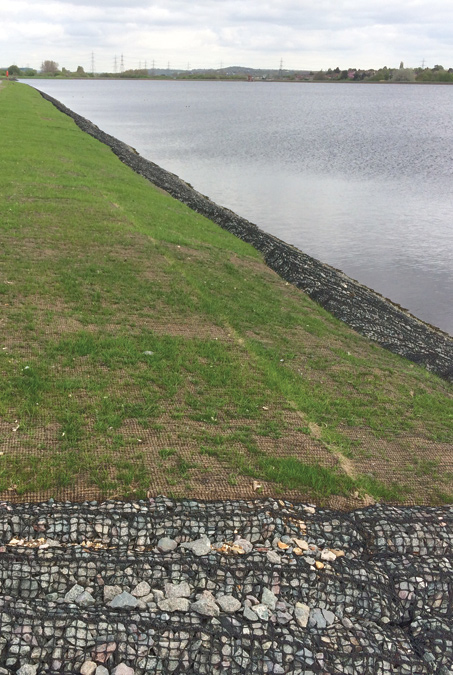
Rock mattresses after the installation of the reservoir Courtesy of Thames Water’s eight2O Alliance
Results and future potential: Crest Road works
The slim crest road design has been proved to be fit for purpose and has provided significant benefits including a reduction of 800 tonnes of construction material and approximately 3200 tonnes of eliminated total excavation waste (reduced from 4000 to 800 tonnes), 38 tonne reduction in carbon and a direct cost saving of £102,000.
There was also a cost saving due to the 8-week reduction in the programme, saving an additional £160,000 (based on a £20,000/week preliminary spend). Reduced vehicle movements and time on site significantly reduced disturbance to the protected birds, as well as the visiting public.
Similar to the Salix mattresses, the lean crest road design on Lockwood Reservoir is another design standard that has not been done for Thames Water before and has the potential to be replicated across the industry.
Results and future potential: Unmanned aerial vehicle (drone) surveys
The project provided an ideal opportunity to trial aerial drone technology to study the impact of construction of spatially large projects on the surroundings. Drone surveys are a non-invasive, low risk method to survey and monitor large and/or inaccessible areas. The drones were used to demonstrate capability in thermal imaging of wildlife habitats to a Natural England officer that had been invited along as a collaborative knowledge sharing opportunity.
Another product from the use of drone surveys was the creation a 3D model of the embankment, which can be used to price future works more effectively and is a valuable tool in client engagement. The drone footage and thermal imagery can also be used by the reservoir engineers as part of their maintenance and inspection duties; and to study the habitat changes over time and the impact on birds from the surrounding works, in a fast, cost effective way.
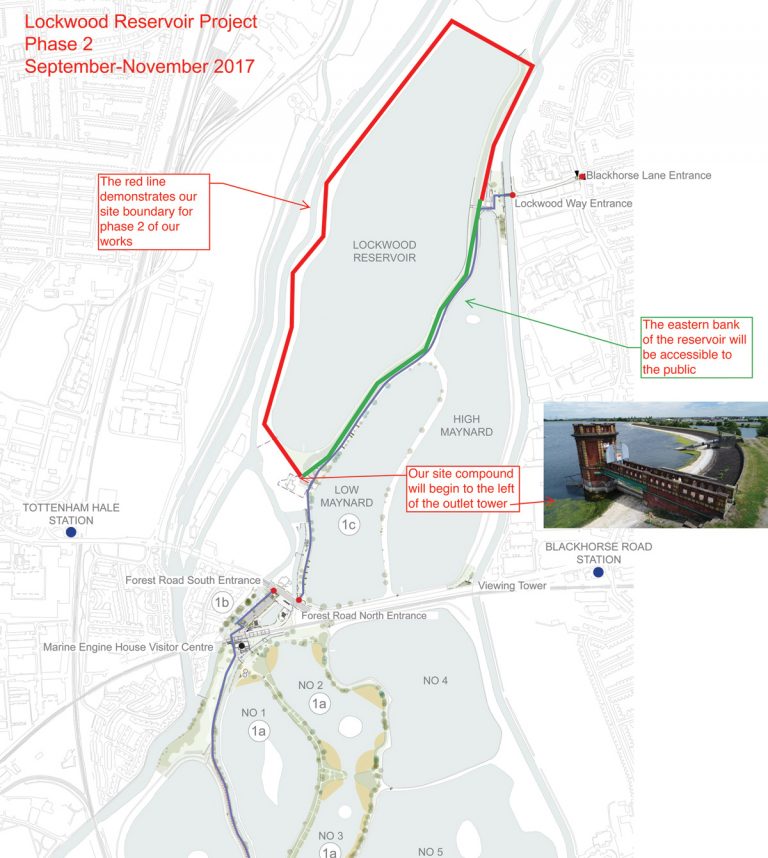
Site plan for phase 2 – Courtesy of Thames Water’s eight2O Alliance
The outputs from these surveys were also used to create informative videos that showcase the innovative solutions employed by eight2O on Lockwood Reservoir. In particular, one of these videos will be shown in the visitors’ centre for the Walthamstow Wetlands, which will help to keep customers informed as well as strengthening the relationship between Thames Water and Walthamstow Wetlands.
There is significant potential to expand drone surveys into a means of monitoring both for engineering purposes and the natural environment e.g. through thermal imagery, and this was demonstrated at Lockwood Reservoir in collaboration with key stakeholders like Natural England and Walthamstow Wetlands Trust.
Public engagement
The site was situated amongst the Walthamstow reservoirs and is fully accessible to the public. For safety reasons, there was no access to Lockwood Reservoir for fishing during the construction hours of 7am-6pm for the duration of the project. As previously stated, sections of the crest road were closed to the public during works and construction access was shared with the public.
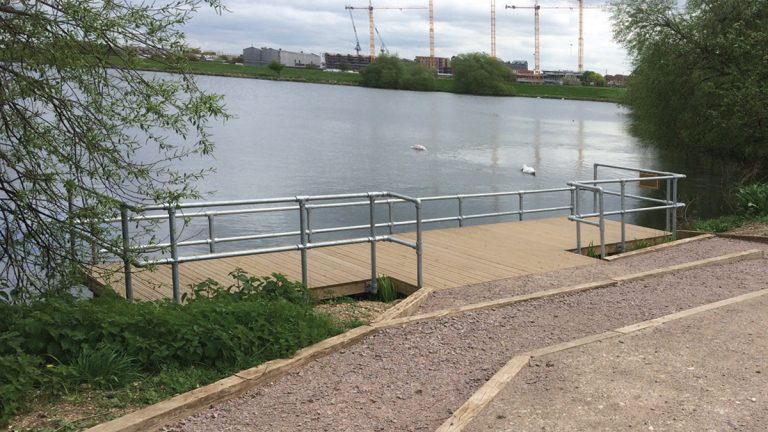
Disabled access fishing platform – Courtesy of Thames Water’s eight2O Alliance
There was therefore a need to engage the public and keep them informed. It was decided that social media would be the most effective way to do this. Information and photographs from the project were posted on Thames Water’s official social media accounts, which were then shared by Walthamstow Wetlands Trust, Waltham Forest Council and fisheries (pages with thousands of followers) to keep stakeholders informed. A project overview board was also displayed at the entrance area to explain the need, timescales and updates on the project. A commendation was received from Walthamstow Wetlands for the stakeholder engagement from Thames Water.
Additionally, a free to use disabled access fishing platform was installed on the Low Maynard Reservoir (adjacent to Lockwood Reservoir) as part of the project. This assisted the Walthamstow Wetlands Trust in their efforts to make the area more accessible.




